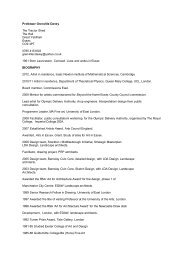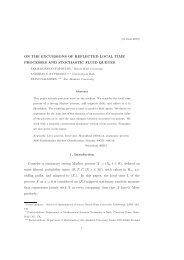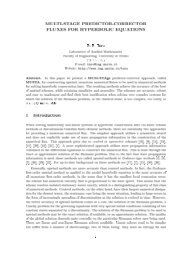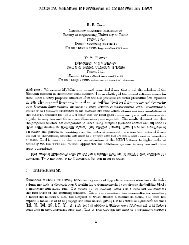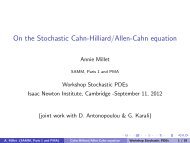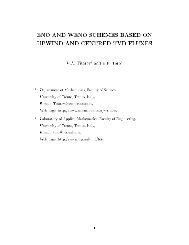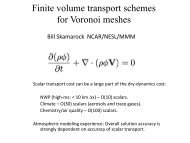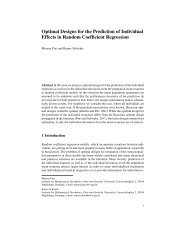A Size Index for Multitape Turing Machines - Isaac Newton Institute ...
A Size Index for Multitape Turing Machines - Isaac Newton Institute ...
A Size Index for Multitape Turing Machines - Isaac Newton Institute ...
Create successful ePaper yourself
Turn your PDF publications into a flip-book with our unique Google optimized e-Paper software.
8 RAINER GLASCHICK<br />
2.7. Penalties. In case the TMs have some quirks that allow fewer states by leaving<br />
out features that the others have, e.g. a missing stop state or requiring a cyclic<br />
tape, penalties may correct <strong>for</strong> these cases. However, penalties depend on human<br />
judgement and thus are estimates. The following rules are applied in the examples:<br />
If one of the tapes is cyclic and read-only, i.e. has a single infinitely repeated<br />
pattern, this saves at least one action and thus reduces the TM index. Maybe it<br />
also increases the computational complexity, but this is not taken into account in<br />
the TM index. Thus, a penalty of one extra operation to compensate <strong>for</strong> the saved<br />
move in the other direction could be applied.<br />
If the tape is infinite, but not filled with blanks, but with a repeating pattern<br />
outside the encoding of the guest machine, this is regarded more complicated than<br />
a cyclic tape, and thus an action penalty of two is used.<br />
If the tape is not only infinite, but also filled with a pattern that is not repeating,<br />
an action penalty of at least three is used.<br />
If there is no stop state easily added, some extra states may be added in the<br />
calculation. The number used should estimate the necessary ef<strong>for</strong>t to determine<br />
the stop situation. If the stop is a cycle of n states, a state penalty of n − 1 is<br />
used, as a coupled FSM to detect the cylcle would need n states. If the stop is not<br />
detected by a defined cycle, the state penalty becomes very large, if not infinite.<br />
At least, the number of states plus 1 will be used.<br />
Thus, using the state penalty PS and the operation penalty PΨ, the <strong>for</strong>mula <strong>for</strong><br />
the estimated TM index becomes:<br />
�<br />
|I| · (|Ψ| + PΨ)<br />
(|S| + PS) ·<br />
2<br />
3. Invariants<br />
Trans<strong>for</strong>mations on standard TMs and their influence on the state symbols product<br />
have been studied since Shannon, and as the TM index is the same, these need<br />
not to be evaluated here.<br />
So here the emphasis is on changes in the number and characteristics of more<br />
than one tape. For these, some machine trans<strong>for</strong>mations can be given that do not<br />
alter the TM index.<br />
3.1. Moving state to an extra tape. Shannon proved that with only one tape,<br />
a 1-state standard UTM is not possible.<br />
If a second tape is allowed, a machine with only 1 state is fairly simple, using the<br />
technique used by Hooper in appendix II of [Hooper1969]. For a standard <strong>Turing</strong><br />
machine, just a second (changeable) tape is added, the number of symbols on this<br />
tape being equal to the number of states. This second tape is never moved, it just<br />
serves to replace the states.<br />
The trans<strong>for</strong>mation of any n-state m-symbol 1-tape machine with the common<br />
two operations is simple: Just use the pairs of the m symbols and n states as inputs,<br />
giving m · n new input symbols, and write the new state to second tape, i.e. use<br />
pairs of new state and new symbol as actions, i.e. m · 2 · n actions. The TM index<br />
� m·m·2<br />
2<br />
� (n·m)·(m·2·n)<br />
was n · be<strong>for</strong>e and is 1 ·<br />
2 thereafter, thus is equal under this<br />
trans<strong>for</strong>mation. Hence, using the square root is essential.<br />
3.2. Many synchronous tapes. Any n-state, m-symbol, 1-tape TM can be simply<br />
trans<strong>for</strong>med to a n-state, 2-symbol, multitape machine, using either unary or<br />
binary representation. All tapes are moved the same each time.<br />
If unary representation is used, m tapes are required, the symbols are represented<br />
by a bit on one of the m tapes only.




